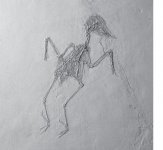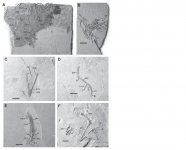Fred Ruhe
Well-known member

Anaïs Duhamel & Antoine Louchart, 2021
A look at the Oligocene fossil avifauna of the Parc du Luberon and its paleobiological implications, incorporating new fossil data
INTRODUCTION
Les calcaires en plaquettes (Formation des Calcaires de Campagne-Calavon) de l’Oligocène inférieur du Luberon (Rupélien, biozone MP23, 31–30 Ma ; nombreuses localités autour de Céreste, Alpes-de-Haute-Provence ; Cavelier, 1984 ; Ducreux et al. , 1985 ; Escarguel et al. , 1997 ; Sigé & Hugueney, 2006) figurent parmi les sites fossilifères importants pour les oiseaux dans le Paléogène français. En effet, cette formation riche en poissons, insectes, et plantes, comprend également des tétrapodes, bien moins fréquents, parmi lesquels les oiseaux sont rares mais dont la préservation est souvent exceptionnelle, comme l’ensemble des fossiles du Parc. Ainsi, la plupart des oiseaux de cette formation sont des squelettes entiers ou presque, et le plus souvent les os sont en articulation, et préservés en trois dimensions avec peu ou pas d’écrasement. Cette qualité de préservation concerne les autres organismes également, faisant des Calcaires de Campagne-Calavon un Konservatlagerstätte*. Des détails de plumage très précis sont parfois préservés aussi, grâce à la finesse du calcaire, comparable aux calcaires lithographiques à Archaeopteryx de Bavière (Allemagne, Jurassique supérieur). Etonnamment, le nombre limité de spécimens (moins de 30) représente un nombre presque aussi grand d’espèces différentes, appartenant à des familles très diverses. Il en ressort la possibilité de déterminer précisément ces fossiles, qui se révèlent souvent être les plus anciens représentants de familles actuelles. Les espèces identifiées permettent de contribuer à reconstituer le paléoenvironnement de cette région il y a près de 30 millions d’années, aux côtés des autres organismes. Elles peuvent être placées dans la phylogénie des oiseaux modernes, dont les nœuds les plus anciens ont été résolus récemment par la phylogénomique (cf. Kuhl et al., 2021, et références incluses). Ostéologiquement, certaines espèces représentées dans les Calcaires de Campagne-Calavon sont très proches de genres actuels, attestant d’une origine ancienne de morphologies modernes. Enfin, dans plusieurs cas, ces fossiles appartiennent à des groupes aurd’hui absents d’Europe, et actuellement tropicaux et/ou américains. Cela révèle des histoires paléobiogéographiques particulières, en lien avec la paléogéographie et l’histoire climatique mondiale. Ces différents aspects sont ici passés en revue, soulignant l’intérêt exceptionnel de cette région dans la connaissance de l’histoire évolutive des oiseaux. Cette synthèse est basée sur l’ensemble des travaux publiés et aussi sur des données inédites.
Enjoy,
Fred
Fig. 1 : Moulage (UCBL-FSL-367903) du passereau de Vachères, Oligocène inférieur, anciennement collection Loggia (Tableau 1 dans l’article). Ce passereau remarquable est un Suboscines (sp. B) différent de trois autres Suboscines de la formation, et l’un des deux seuls complets avec le Tyrannida de Revest-des-Brousses.
A look at the Oligocene fossil avifauna of the Parc du Luberon and its paleobiological implications, incorporating new fossil data
INTRODUCTION
Les calcaires en plaquettes (Formation des Calcaires de Campagne-Calavon) de l’Oligocène inférieur du Luberon (Rupélien, biozone MP23, 31–30 Ma ; nombreuses localités autour de Céreste, Alpes-de-Haute-Provence ; Cavelier, 1984 ; Ducreux et al. , 1985 ; Escarguel et al. , 1997 ; Sigé & Hugueney, 2006) figurent parmi les sites fossilifères importants pour les oiseaux dans le Paléogène français. En effet, cette formation riche en poissons, insectes, et plantes, comprend également des tétrapodes, bien moins fréquents, parmi lesquels les oiseaux sont rares mais dont la préservation est souvent exceptionnelle, comme l’ensemble des fossiles du Parc. Ainsi, la plupart des oiseaux de cette formation sont des squelettes entiers ou presque, et le plus souvent les os sont en articulation, et préservés en trois dimensions avec peu ou pas d’écrasement. Cette qualité de préservation concerne les autres organismes également, faisant des Calcaires de Campagne-Calavon un Konservatlagerstätte*. Des détails de plumage très précis sont parfois préservés aussi, grâce à la finesse du calcaire, comparable aux calcaires lithographiques à Archaeopteryx de Bavière (Allemagne, Jurassique supérieur). Etonnamment, le nombre limité de spécimens (moins de 30) représente un nombre presque aussi grand d’espèces différentes, appartenant à des familles très diverses. Il en ressort la possibilité de déterminer précisément ces fossiles, qui se révèlent souvent être les plus anciens représentants de familles actuelles. Les espèces identifiées permettent de contribuer à reconstituer le paléoenvironnement de cette région il y a près de 30 millions d’années, aux côtés des autres organismes. Elles peuvent être placées dans la phylogénie des oiseaux modernes, dont les nœuds les plus anciens ont été résolus récemment par la phylogénomique (cf. Kuhl et al., 2021, et références incluses). Ostéologiquement, certaines espèces représentées dans les Calcaires de Campagne-Calavon sont très proches de genres actuels, attestant d’une origine ancienne de morphologies modernes. Enfin, dans plusieurs cas, ces fossiles appartiennent à des groupes aurd’hui absents d’Europe, et actuellement tropicaux et/ou américains. Cela révèle des histoires paléobiogéographiques particulières, en lien avec la paléogéographie et l’histoire climatique mondiale. Ces différents aspects sont ici passés en revue, soulignant l’intérêt exceptionnel de cette région dans la connaissance de l’histoire évolutive des oiseaux. Cette synthèse est basée sur l’ensemble des travaux publiés et aussi sur des données inédites.
Enjoy,
Fred
Fig. 1 : Moulage (UCBL-FSL-367903) du passereau de Vachères, Oligocène inférieur, anciennement collection Loggia (Tableau 1 dans l’article). Ce passereau remarquable est un Suboscines (sp. B) différent de trois autres Suboscines de la formation, et l’un des deux seuls complets avec le Tyrannida de Revest-des-Brousses.
Attachments
Last edited:








